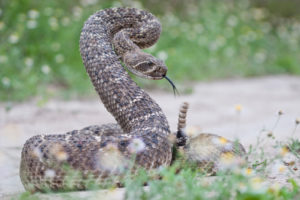
Let’s be honest: there has been a lot of crazy stuff in the news lately with respect to people (especially kids) being attacked by animals. And while most of these events have been very unfortunate yet very rare occurrences, the momma bear in me starts to wonder what native predators live in my own backyard!
So here is the first post in a series that will explore local predators inhabiting Northern California. If you are a San Fran resident, perhaps your most life-threatening encounter is with someone racing to catch the BART, but if you live on the peninsula or enjoy going hiking, biking or running in nature, then keep reading.
After reading this article about a recent invasion of Rattlesnakes in San Carlos, I decided my first segment needed to cover these slithery rattlers to learn more about them, because unfortunately my anxiety can often present more like ignorant paranoia. When I went for a run this weekend, I was hyper-vigilant anytime I ran by a grass field, 100% convinced that a Rattlesnake was in my midst and ready to pounce at any second!
Below you will find information I gathered from California’s wildlife.gov website.
Rattlesnakes: California’s only native venomous snake
How and Why Snakebites happen:
- Rattlesnakes are generally not aggressive, but may strike if they feel threatened or deliberately provoked. If given space they will usually retreat
- Rattlers hiss and rattle their tails as a sign that they feel threatened and might strike
- Most snakebites occur when the snake is handled or accidentally touched by someone walking or climbing
- The majority of snakebites occur on the hands, feet and ankles
- Rattlesnake bites rarely cause serious injury: there are a reported 800 rattlesnake bites per year with only 1-2 deaths
- Most bites occur between April and October when people and snakes are most active outdoors
- About 25% of bites are “dry”, meaning no venom was injected; these bites still require medical attention
Ways to Prevent Rattle Snake Bites:
- When hiking, stick to well-used trails, wear over-the-ankle hiking boots and loose-fitting long pants. Avoid tall grass, weeds and heavy underbrush. Never go barefoot!
- Do not step or place hands where you cannot see
- Check out stumps or logs before sitting down, and shake out sleeping bags before use
- Never grab “sticks” or “branches” while swimming in lakes and rivers. Rattlesnakes can swim!
- Teach children early to respect snakes and to leave them alone. Children are naturally curious and will pick up snakes.
Distinguishing Features of A Rattlesnake:
- Heavy-bodied, blunt-tailed snake with one or more rattles on the tail
- Triangular-shaped head, much broader at the back than at the front, and a distinct “neck” region
- A series of dark and light bands near the tail, just before the rattles which are different from the markings on the rest of the body
- Just to confuse things, rattles may not always be present, as they are often lost through breakage and are not always developed in the young
How to Keep Snakes out of your Yard:
- Make a “rattlesnake proof” fence out of solid or mesh material. It should be at least three feet high with the bottom buried a few inches in the ground. Slant your fence outward at about a 30-degree angle.
- Remove piles of boards or rocks around the home.
- Avoid having open garbage bins, pools or other sitting sources of water
What to do in the Event of a Snakebite:
The California Poison Control Center advises:
- Stay calm: Generally, the most serious effect of a rattlesnake bite to an adult is local tissue damage which needs to be treated. Children, because they are smaller, are in more danger if they are bitten
- Wash the bite area gently with soap and water
- Remove watches, rings, etc, which may constrict swelling
- Immobilize the affected area and keep it below the heart
- Transport safely to the nearest medical facility ASAP
Fun Facts:
- Rattlesnakes mothers incubate their own eggs and give birth to live young
- They are the newest and most evolved species of snake in the world
- Venom is composed of neurotoxins (attack nervous system) and/or hemotoxins (attack circulatory system)
- Snakes can meter the dosage of venom to prey
- Rattlers live in dens and will often share the same one generation after generation
All above information was provided by https://www.wildlife.ca.gov/News/Snake
Next up? Mountain Lions!


















